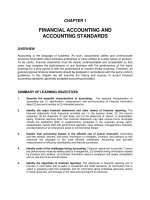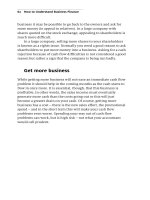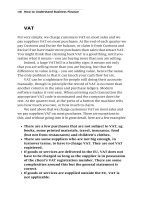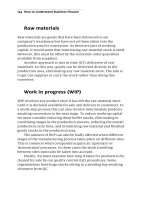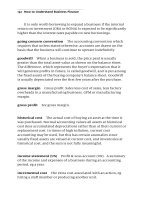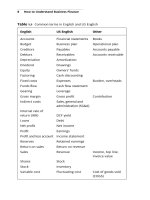Accounts demystified how to understand financial accounting and analysis
Bạn đang xem bản rút gọn của tài liệu. Xem và tải ngay bản đầy đủ của tài liệu tại đây (4.15 MB, 313 trang )
About the author
Accounts Demystified
how to understand financial accounting and analysis
“An excellent primer on accounting, this book explains in simple
language how to understand balance sheets, profit and loss
accounts and cash flow statements. It also has useful chapters
covering important subjects like return on capital employed, gearing
and book values as well as providing insight into the tricks of the
accounting trade.”
Jim Slater, investment guru and best selling author of The Zulu Principle
Accounts Demystified
Anthony Rice is not an accountant. He
learned his accounting the hard way – by
keeping the accounts for his own company.
It wasn’t until the fifth consecutive
weekend in the office struggling with the
accounting system that he realised, quite
suddenly, how simple it all is. From that
day, accounting lost its mystery. Over the
next couple of years, he also found that, by
focusing on the balance sheet and using
diagrams, he could quickly demystify
fellow sufferers. Having subsequently
spent much of his time analysing
companies, first as a strategy consultant
and more recently when looking for
businesses to buy, he has some valuable
insights into financial analysis. He now
divides his time between his businesses
and demystifying other subjects that ‘just
can’t be as hard as they seem’. His next
book, Statistics Demystified, is available
from Prentice Hall Business in spring
2003.
BOOKS
THAT MAKE
YOU BETTER
“You won’t find a better explanation of the fundamentals of accounting
and financial analysis than this. Trust me – no other book makes the
subject as simple and clear.”
Jamie Reeve, Lynx Capital Ventures
“Explains what many people find a complicated subject in very clear and
simple terms. I will be recommending this book to all our new trainees.”
Jonathan Munday, Partner, Rees Pollock Accountants
Anthony Rice
Accounting is generally viewed as a highly technical and complex subject. In
truth, it is actually based on an incredibly simple principle that is hundreds
of years old. Once you understand this principle and how it is applied, you
will find accounting and financial analysis easy.
In this straightforward, easy to read book, the author guides you with
extraordinary clarity through this principle and onto all the major
accounting concepts. Using simple diagrams and everyday analogies, this
book will help you really understand:
• balance sheets, profit and loss accounts and cash flow statements
• how they all work together
• the meaning of all the major features of annual reports
• how to analyse a company’s financial performance
• why return on capital employed is the measure that matters
• how creative accountants cook the books and how to spot it.
Accounts Demystified is the definitive, user-friendly guide to the
fundamental principles of accounting that no novice user of accounts can
do without.
£14.99
––––––––––––––––––
BUSINESS
––––––––––––––––––
ISBN 0-273-66334-8
Visit us on the web
www.business-minds.com
www.yourmomentum.com
Cover photograph © Stone 2003
9 780273 663348
Prentice Hall Business is an imprint of Pearson Education
Prentice
Hall
Prentice
Hall
BUSINESS
BUSINESS
Whether you are a manager on the way up,
a trainee accountant, an entrepreneur, a
student or an investor – this book is for you.
In fact, it is for anybody who wants to be
able to look at a balance sheet, profit and
loss account or cash flow statement and
understand, digest and talk about the
numbers with confidence. In this 4th edition
of the classic Accounts Demystified,
Anthony Rice makes accounting
astonishingly simple and pain-free.
Accounts
Demystified
Prentice
Hall
BUSINESS
Books to make you better
Books to make you better. To make you be better, do better,
feel better. Whether you want to upgrade your personal skills
or change your job, whether you want to improve your
managerial style, become a more powerful communicator, or
be stimulated and inspired as you work.
Prentice Hall Business is leading the field with a new breed of
skills, careers and development books. Books that are a cut
above the mainstream – in topic, content and delivery – with
an edge and verve that will make you better, with less effort.
Books that are as sharp and smart as you are.
Prentice Hall Business.
We work harder – so you don’t have to.
For more details on products, and to contact us, visit
www.business-minds.com
www.yourmomentum.com
Pearson
Education
ANTHONY RICE
Accounts
Demystified
How to understand financial
accounting and analysis
an imprint of
Pearson Education
London • New York • Toronto • Sydney • Tokyo • Singapore • Hong Kong • Cape Town
New Delhi • Madrid • Paris • Amsterdam • Munich • Milan • Stockholm
PEARSON EDUCATION LIMITED
Head Office:
Edinburgh Gate
Harlow CM20 2JE
Tel: +44 (0)1279 623623
Fax: +44 (0)1279 431059
London Office:
128 Long Acre
London WC2E 9AN
Tel: +44 (0)20 7447 2000
Fax: +44 (0)20 7447 2170
Website: www.business-minds.com
____________________________
First published in Great Britain in 1993
© Anthony Rice 2003
The right of Anthony Rice to be identified as Author of this Work has been asserted
by him in accordance with the Copyright, Designs and Patents Act 1988.
ISBN 0 273 66334 8
British Library Cataloguing in Publication Data
A CIP catalogue record for this book can be obtained from the British Library
All rights reserved; no part of this publication may be reproduced, stored in a retrieval
system, or transmitted in any form or by any means, electronic, mechanical, photocopying,
recording, or otherwise without either the prior written permission of the Publishers or a
licence permitting restricted copying in the United Kingdom issued by the Copyright
Licensing Agency Ltd, 90 Tottenham Court Road, London W1T 4LP. This book may not be
lent, resold, hired out or otherwise disposed of by way of trade in any form of binding or
cover other than that in which it is published, without the prior consent of the Publishers.
10 9 8 7 6 5 4 3 2 1
Typeset by Northern Phototypesetting Co. Ltd, Bolton
Printed and bound in Great Britain by Bell & Bain Ltd, Glasgow
The Publishers’ policy is to use paper manufactured from sustainable forests.
Contents
Preface ix
Acknowledgements xi
Prologue xiii
Introduction xv
Part I: The basics of accounting
1 The balance sheet and the fundamental
principle 3
●
Assets, liabilities and balance sheets 3
●
Sarah’s ‘personal’ balance sheet 4
●
The balance sheet of a company 7
●
The balance sheet chart 11
●
Summary 14
2 Creating a balance sheet
17
●
Procedure for creating a balance sheet 17
●
SBL’s balance sheet 18
●
The different forms of balance sheet 48
●
Basic concepts of accounting 50
●
Summary 53
3 The profit & loss account and cash flow
statement 55
●
The profit & loss account 55
●
The cash flow statement 57
●
‘Definitive’ vs ‘descriptive’ statements 59
●
Summary 61
v
CONTENTS
4 Creating the profit & loss account and
cash flow statement 63
●
Creating the profit & loss account 63
●
Creating the cash flow statement 67
●
Summary 78
5 Book-keeping jargon
81
●
Basic terminology 81
●
The debt and credit convention 84
Part II: Interpretation of accounts
6 Wingate’s annual report
95
●
Accounting rules 96
●
The reports 97
●
Assets 99
●
Liabilities 107
●
Shareholders’ equity 114
●
The P&L and cash flow statement 115
●
The notes to the accounts 118
●
Summary 119
7 Further features of company accounts
vi
●
Investments 122
●
Associates and subsidiaries 124
●
Accounting for associates 125
●
Accounting for subsidiaries 127
●
Funding 128
●
Debt 129
●
Equity 131
●
Revaluation reserves 134
●
Statement of recognised gains and losses 135
●
Note of historical cost profits and losses 135
121
CONTENTS
●
Intangible fixed assets 137
●
Leases 137
●
Corporation tax 140
●
Exchange gains and losses 141
●
Fully diluted earnings per share 143
●
Summary 146
Part III: Analysing company accounts
8 Financial analysis – introduction
149
●
The ultimate goal 150
●
The two components of a company 153
●
The general approach to financial analysis 162
●
Wingate’s highlights 163
●
Summary 166
9 Analysis of the enterprise
169
●
Return on capital employed (ROCE) 169
●
The components of ROCE 173
●
Where do we go from here? 177
●
Expense ratios 177
●
Capital ratios 184
●
Summary 192
10 Analysis of the funding structure
●
The funding structure ratios 195
●
Lenders’ perspective 199
●
Gearing 201
●
Shareholders’ perspective 205
●
Liquidity 211
●
Summary 215
195
vii
CONTENTS
11 Valuation of companies
●
Book value vs market value 217
●
Valuation techniques 220
●
Summary 225
12 Tricks of the trade
●
Self-serving presentation 228
●
Creative accounting 230
●
Why bother? 249
●
Summary 252
Glossary 253
Appendix 275
Index 286
viii
227
217
Preface
A glance at the accounts of most of Britain’s larger companies could
lead you to conclude that accounting is a very complex and technical
subject.
While it can be both of these things, accounting is actually based on an
incredibly simple principle which was devised more than 500 years ago
and has remained unchanged ever since. The apparent complexity of
many companies’ accounts results from the rules and terminology that
have developed around this fundamental principle to accommodate
modern business practices.
I believe that, once you really understand the fundamental principle
and how it is applied, you will find that the rules and terminology
follow logically and easily. This view determines the arrangement of the
chapters in Accounts Demystified and it is important, therefore, to read
them chronologically. You may, however, omit Chapter Five, which discusses book-keeping jargon and Chapter Seven, which concentrates on
more sophisticated areas of accounting, without losing the thread of
the book.
May I also suggest that, before you reach Chapter Six, you photocopy
the key parts of Wingate Foods’ accounts (pages 278 to 285). From
Chapter Six onwards, the text refers to these pages frequently and you
will find it much easier with copies in front of you.
If you have any comments on the book, you are welcome to email me
at
Anthony Rice
ix
This book is dedicated
to Charlotte
x
Acknowledgements
A number of people have contributed to this book.
I am especially grateful to Jonathan Munday and Simon Rees, partners
of accountants Rees Pollock. Jonathan reviewed this edition in detail
and helped update the book for the large number of new rules that have
been instituted since first publication. In some cases, I have decided
to live with technical errors and omissions in the interests of clarity.
For such decisions I am solely responsible.
I would also like to thank the following who volunteered to read this
book and all of whom made valuable comments and suggestions:
Michael Gaston, Debbie Hastings-Henry, Steve Holt, Alex Johnstone,
Keith Murray, Jamie Reeve, Brian Rice, Clive Richardson, David
Tredrea, Martin Whittle, Charlie Wrench.
Anthony Rice
xi
Prologue
Sarah
Sarah is the owner and sole employee of a company called Silk
Bloomers Limited (known as SBL). Just over a year ago, she went on a
business trip to the Far East where, by chance, she came across a company producing silk plants and flowers of exceptional quality. On her
return to the UK she immediately quit her job and set up SBL (with
£10,000 of her own money) to import and distribute these silk plants.
Sarah is a born entrepreneur and the prospects for her business look
extremely good. Her only problem is that, since the company has just
finished its first year, she has to produce the annual accounts. She has
kept good records of all the transactions the company made during the
year, but she doesn’t know how to translate them into the required
financial statements. She is determined not to pay her accountants a big
fee to do it for her.
Tom
Tom has two problems.
The first relates to his employer, Wingate Foods, where he is sales
manager. Wingate manufactures confectionery and chocolate biscuits,
mostly for the big supermarkets to sell under their own names. Four
years ago, the company appointed a new managing director who
immediately embarked on an aggressive expansion programme.
Tom’s concern is that the managing director seems to want to win
orders at almost any cost. Simultaneously, the company is spending a
lot of money on new offices and machinery. The managing director is
xiii
P R O LO G U E
brimming with confidence and continually refers to the steady rise in
sales, profits and dividends. Nonetheless, Tom has the nagging suspicion that something is badly wrong. He just can’t put his finger on it.
Tom’s other ‘problem’ is that he has some spare cash which is currently
on deposit at the bank. Tom doesn’t have Sarah’s entrepreneurial spirit
and there’s no chance of him risking his money on starting a business.
He feels, though, that he should perhaps risk a small amount on the
stock market. He has been given a couple of ‘tips’ but would like to
check them out for himself.
Tom has therefore decided it is time to learn how to read company
accounts so he can form his own opinion of both Wingate and his
prospective investments.
Chris
Chris is a financial journalist for a national newspaper who, although
not an accountant, can read and analyse company accounts with
confidence.
This was not always the case. Chris used to be one of the thousands of
people who understand a profit and loss account but find the balance
sheet a total mystery. A few years ago, however, a friend explained the
fundamental principle of accounting to him and showed him how
everything else follows logically from it. Within hours, his understanding of balance sheets and everything else to do with company accounts
was transformed.
Recently, Tom and Sarah mentioned their respective accounting problems to Chris. Chris began enthusing about the approach he had been
taught and how easy it all was once you really understood the basics.
Sarah, never one to miss an opportunity, immediately demanded that
Chris should give up his weekend to share the ‘secret’ with Tom and
herself.
xiv
Introduction
Wingate’s annual report
Before we do anything, I think we should have a quick look at Wingate’s
most recent annual report and accounts (which is what we really
mean by the phrase ‘annual report’). We are going to be referring to this
a lot and I think you’ll find it helpful to get to know your way around it
now. It will also give you an idea of what we’re trying to achieve. By the
end of this weekend, you should not only understand everything in this
annual report, you should also be able to analyse it in detail.
The other thing I should do is give you a brief outline of how I plan to
structure the weekend in order to achieve that objective. After that, we
might as well go straight into the first session.
Wingate’s annual report for year five [reproduced on pages 275 to 285]
is a fairly typical annual report for a medium-sized company. As you can
see, it consists of six items:
●
Directors’ report
●
Auditors’ report
●
Profit & loss account
●
Balance sheet
●
Cash flow statement
●
Notes to the accounts
The directors’ report and the auditors’ report don’t usually tell us a
great deal. You must always read them, however, particularly the auditors’ report. We’ll come back to them later and see why.
xv
INTRODUCTION
The profit & loss account (the ‘P&L’, for short), the balance sheet
and the cash flow statement are the real heart of an annual report.
Everything we’re going to talk about is really geared towards helping
you to understand and analyse these three ‘statements’.
The notes to the accounts are a lot more than just footnotes. They
contain many extremely valuable details which supplement the information in the three main statements. You can’t do any meaningful
analysis of a company without them.
You do realise, Chris, that I hardly understand a word of what I’m looking
at here?
Structure outline
That’s fine. I’m going to assume you know absolutely nothing and take
it very slowly. What we’re going to do is to break the weekend up into
12 separate sessions which fall into three distinct parts:
I
The basics of accounting
II Interpretation of accounts
III Analysing company accounts
I The basics of accounting
The basics will take up our first four sessions.
●
In the first session, I will explain what a balance sheet is and how it
relates to the fundamental principle of accounting.
●
Session 2 will be spent actually drawing up the balance sheet for
your company, Sarah. I know you’re not interested in creating
accounts, Tom, but this session is important to understanding how
the fundamental principle is applied in practice.
xvi
INTRODUCTION
●
In session 3, I will explain, briefly as it’s very straightforward, what
a P&L and cash flow statement are and how they are related to the
balance sheet.
●
Then in session 4, we will actually draw up the P&L and cash flow
statement for SBL.
●
Finally, in session 5, I will introduce you to some jargon you may
actually find useful.
Why are you starting with the balance sheet? In Wingate’s annual report, the
P&L comes first and that’s the bit I vaguely understand. Shouldn’t we start there?
No, we should not. The balance sheet really ought to come before the
P&L; you’ll see why later.
II Interpretation of accounts
At the end of session 5, you should understand the basics of accounting and you may well find that you can look at Wingate’s accounts and
understand the vast majority of what’s in there!
There are, however, quite a few rules and a lot of terminology that we
need to cover before you can read any set of company accounts with
confidence.
●
In session 6, we will work our way through the whole of Wingate’s
accounts, which will bring out most of the features you are likely to
encounter in the average company.
●
In session 7, I will briefly explain some further features of accounts
which are common in larger companies; these, after all, are the companies you are likely to be investing in, Tom.
III Analysing company accounts
It’s all very well to know what a company’s accounts mean, but it
doesn’t actually give you any insight into the company. That’s why you
have to know how to analyse accounts.
xvii
INTRODUCTION
I will start, in session 8, by introducing the whole subject of financial
analysis to make sure we are all clear about what companies are trying
to achieve and how, for the purposes of analysis, we separate a company
into two components – the enterprise and the funding structure.
In sessions 9 and 10 respectively we will then analyse the enterprise
and the funding structure of Wingate Foods.
Up to this point, all our analysis will have been about understanding
the financial performance of companies. We will not have related any of
it to the value of the company, which is what potential investors are
interested in. I do not plan to go into detailed investment analysis but
I will, in session 11, explain how most investors relate the performance of a company to its valuation.
I will end, in session 12, with a summary of how, through a combination of careful presentation and creative accounting, companies try to
‘sell’ themselves to investors.
After that, you’re on your own.
xviii
IThe basics of
PA R T
accounting
As well as listing your assets and liabilities and
showing that you are worth £31,000, your balance
sheet also shows how you came to be worth
that much.
1
CHAPTER
The balance sheet and the
fundamental principle
●
●
●
●
●
Assets, liabilities and balance sheets
Sarah’s ‘personal’ balance sheet
The balance sheet of a company
The balance sheet chart
Summary
What I’m going to do first is explain what assets and liabilities are,
which may seem trivial but it’s important there are no misunderstandings. Next, I will explain what a balance sheet is and show you how to
draw up your own personal balance sheet. We will then relate this to a
company’s balance sheet.
At that point, I will, finally, explain what I mean by the fundamental
principle of accounting and you will see that the balance sheet is just
the principle put into practice. I will also show you how we can represent the balance sheet in chart form, which I think you will find a lot
easier to handle than tables full of numbers.
Then we’ll take a break before we actually set about building up SBL’s
balance sheet.
Assets, liabilities and balance sheets
Typically, individuals and companies both have assets and liabilities.
An asset can be one of two things. It is either:
3
ACCOUNTS DEMYSTIFIED
●
something you own; for example, money, land, buildings, goods,
brand names, shares in other companies etc., or
●
something you are owed by someone else, i.e. something which is
technically yours, but is currently in someone else’s possession.
More often than not, it’s money you are owed, but it could be
anything.
A liability is anything you owe to someone else and expect to have to
hand over in due course. Liabilities are usually money, but they can be
anything.
A balance sheet is just a table, listing all someone’s assets and liabilities, along with the value of each of those assets and liabilities at a
particular point in time.
Sarah’s ‘personal’ balance sheet
You can’t say that’s a difficult concept, can you? Let’s see how it works
by writing down on a single sheet of paper all Sarah’s assets and
liabilities. We will then have effectively drawn up her personal balance
sheet. I think you’ll find it pretty interesting [See Table 1.1.]
The top part of this is fine, Chris. We’ve just got a simple list of all my main
assets and their values. We’ve also got a list of the amounts that I owe to other
people.
There are several things here, though, that I don’t understand. Why are the
liabilities in brackets and what do you mean by ‘Net assets’ – I’m never sure
what people are talking about when they use the word ‘net’.
‘Net’ just means the value of something after having deducted something else. The reason you’re never sure what people mean is that they
don’t explain what it is they’re deducting.
4
T H E B A L A N C E S H E E T A N D T H E F U N D A M E N TA L P R I N C I P L E
SARAH’S PERSONAL BALANCE SHEET
As at today
£
Assets
House/contents
Investment in SBL
Pension scheme
Jewellery
Loan to brother
50,000
10,000
2,000
1,000
500
Total
Liabilities
Mortgage
Credit card
Overdraft at bank
Phone bill outstanding
£
63,500
(30,000)
(500)
(1,500)
(500)
Total
(32,500)
Net assets
Net worth
Inheritance
Savings
Total
31,000
20,000
11,000
31,000
Note: Brackets are used to signify negative numbers.
Table 1.1 Sarah’s personal balance sheet
In this case, we add up all your assets, which total £63,500. These are
your gross assets, although we usually leave out the ‘gross’ and just
call them your ‘assets’. We then deduct all your liabilities from these
assets. The brackets are common notation in the accounting world to
5
ACCOUNTS DEMYSTIFIED
indicate negative numbers, because minus signs can be mistaken for
dashes. Your liabilities total £32,500 so when we deduct this figure
from your gross assets we are left with £31,000. These are your net
assets.
Your net assets are what you would have left if you sold all your
assets for the amounts shown and paid off all your liabilities. In
other words, your net assets are what you are worth.
OK, so we’ve listed my assets and liabilities and shown what the net value of
them is. That seems to fit your description of a balance sheet. So what’s this
whole bit at the bottom headed ‘Net worth’?
A fair question. My description of a balance sheet wasn’t entirely accurate. As well as listing your assets and liabilities and showing that you
are worth £31,000, your balance sheet also shows how you came to be
worth that much.
So how could you have come to be worth £31,000? There are only
two ways:
1 You could have been given some of your assets. In your case you
inherited £20,000. This is effectively what you ‘started’ out in life
with; you didn’t have to earn it.
2 You could have saved some of your earnings since you first started
work. I don’t just mean savings in the form of cash in a bank account
or under your bed. I also include savings in the form of any asset that
you could sell and turn into cash, such as your house, jewellery etc.
In other words, your savings means all your earnings that you
haven’t spent on things like food, drink and holidays, which are gone
for ever.
In your case, you have saved a total of £11,000 in your life so far. To
emphasise the point, notice that your balance sheet does not show
£11,000 in cash; your £11,000 savings are in the form of various assets.
6

